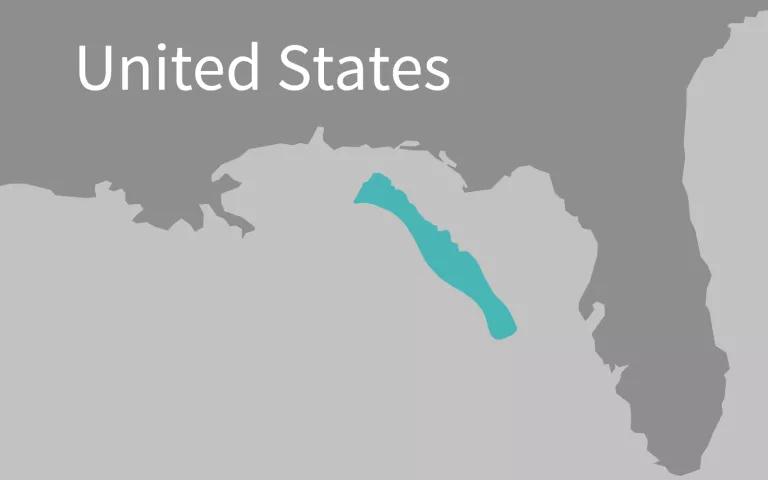
Did you know one of the most endangered whales on Earth lives just off the Florida panhandle?
If not, then rest assured you are not alone; few people have heard of the majestic yet elusive Gulf of Mexico whale. Sadly, one of their most notable features is their dismally low abundance. It’s estimated that only 33 of them are alive today.
Already teetering on the brink of extinction, the whales now face an unprecedented dual attack from the oil and gas industry.
The “SECURE American Energy Act” (H.R. 4239) was a bill passed out of the House Natural Resources Committee in early November. If signed into law by President Trump, the Act would give the oil industry dangerous access to our nation’s waters, without protection for whales and dolphins or our ocean’s health. The Act also would eviscerate the Marine Mammal Protection Act (MMPA)—which has protected many of the ocean’s most iconic species for 45 years—by eliminating basic safeguards on harmful activities, like offshore oil exploration.
And any day now, Interior Secretary Ryan Zinke, is expected to propose a new draft Five Year Offshore Oil and Gas Leasing program that will direct which U.S. coasts will be opened up for the oil industry. Despite the known risks (the BP Deepwater Horizon oil spill in 2010 represents one of the worst environmental catastrophes in the nation’s history), the eastern Gulf – and the last sliver of habitat left for the Gulf of Mexico whale just off the Florida panhandle – is directly in the industry’s crosshairs.
The oil footprint from the 2010 Deepwater Horizon disaster covered 48 percent of the Gulf of Mexico whale’s habitat. An estimated 17 percent of the species was killed, and 22 percent of reproductive females experienced reproductive failure due to the spill.
If oil and gas development proceeds in the eastern Gulf, there would likely be no hope of the Gulf of Mexico whale recovering from its path towards extinction.

Gulf of Mexico whales are magnificent, filter-feeding baleen whales and are related to Bryde’s whales (pronounced “BROO-dus”), named after the 19th Century Norwegian whaler, John Bryde. Gulf of Mexico whales are highly distinctive from other Bryde’s whales, however. They differ in size, communicate using unique calls, and are now confirmed to be at least a genetically separate subspecies.
Earlier this year, the IUCN Red List (which publishes internationally recognized levels of endangerment for all species on earth) determined that the Gulf of Mexico whale is “Critically Endangered,” meaning it’s considered to be “facing an extremely high risk of extinction in the wild.” Last December, I reported that the National Marine Fisheries Service (NMFS) released their proposed listing of the Gulf of Mexico whale as an “endangered species” under the Endangered Species Act. The whales’ endangered status is largely because of oil and gas activity. The proposed listing followed a NRDC petition submitted to NMFS in September 2014.
Oil and gas already represents one of the main industries responsible for the decline of the Gulf of Mexico whale. The western Gulf has been open for seismic exploration and drilling for years. This is one reason we think the Gulf of Mexico whale lives in the baleen whale equivalent of a postage stamp of habitat in the northeastern corner of the Gulf, in the deep and unusually ‘S-shaped’ De Soto Canyon. The waters of the De Soto Canyon have been shown to be relatively quiet compared to the rest of the Gulf of Mexico, providing a refuge for the Gulf of Mexico whale away from the industrial din to the west.
CLICK HERE

seismic_blast.mp3 (Credit: Scripps Institute of Oceanography) to listen to how loud a single seismic blast sounds. When exploring for oil and gas, multiple blasts are emitting simultaneous every 10-12 seconds, 24 hours a day, for months on end. This causes serious harm to marine mammals and other marine life.

The oil industry is pushing for the House of Representatives to vote on the SECURE American Energy Act as soon as possible. We are also expecting the new draft Five Year Offshore Oil and Gas Leasing program to be released in the coming days.
You can help the Gulf of Mexico whales by demanding that your members of Congress strongly oppose the SECURE Act and its attack on all marine mammals. And you can also be ready to say NO to the damaging actions of the Five-Year Offshore Oil and Gas Leasing program.
Please sign our petition and find the office of your Congressional representative and give them a call

